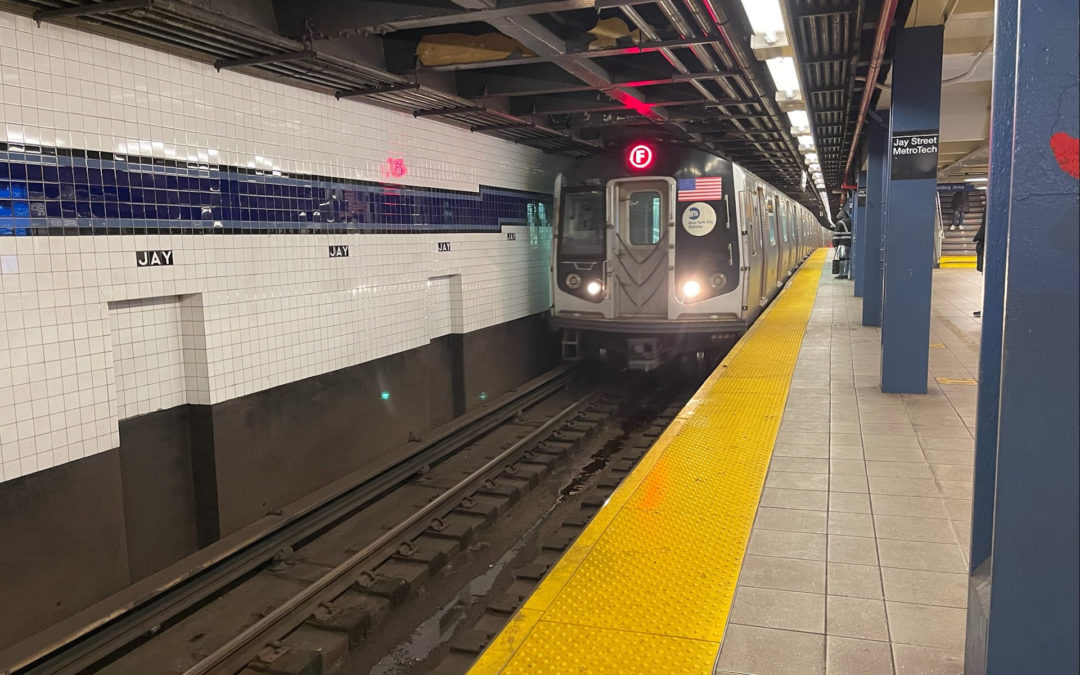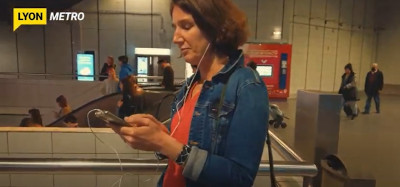Accessibility will have a new face at the Olympic and Paralympic Village in Greater Paris.

How to Foster Inclusive Mobility at Public Transit?

How to Foster Inclusive Mobility at Public Transit?
Vous avez probablement entendu parler de mobilité inclusive, mais savez-vous ce que cela signifie concrètement ? Pour les transports publics du monde entier, cette notion prend de plus en plus d’importance et devient plus réaliste à mettre en œuvre, car de nombreuses solutions d’accessibilité permettent aux personnes handicapées d’utiliser les transports publics.
Car c’est précisément ce qu’implique la mobilité inclusive. Elle offre aux personnes en situation de handicap plus de liberté et de spontanéité pour se rendre facilement au travail, assister au récital de leur enfant, boire un verre avec leurs amis…
Voyons quelles solutions de mobilité inclusive vous pouvez mettre en place pour les transports en commun de votre ville. Vous pourrez ainsi offrir un service de qualité aux usagers en situation de handicap.
Qu’est-ce que la mobilité inclusive ?
Un concept dont vous avez sûrement entendu parler, mais que vous n’avez peut-être pas pris le temps de décrypter. Que signifie la mobilité inclusive ?
Il s’agit de créer un environnement sans barrières où tous les types d’utilisateurs, quels que soient leurs capacités, peuvent facilement aller et venir.
Après tout, la mobilité est la capacité de se déplacer librement. Et l’inclusion représente l’idée que chacun devrait pouvoir se rendre dans n’importe quel lieu, profiter des mêmes activités ou expériences, bénéficier des mêmes services …
Bien entendu, cela concerne les personnes handicapées. Pour que la mobilité inclusive devienne une réalité pour elles, les transports en commun doivent être accessibles.
Plusieurs idées sont en jeu avec la mobilité inclusive pour les personnes handicapées :
⊗ Améliorer leur indépendance, leur autonomie et leur spontanéité dans leurs déplacements,
⊗ S’assurer qu’ils n’ont pas à s’adapter aux transports en commun . C’est aux transports en commun de s’adapter à leurs besoins et à leurs capacités.
⊗ Leur offrir les mêmes choix qu’à tout le monde : la possibilité d’utiliser les transports en commun s’ils le souhaitent.
Quelles solutions permettent une mobilité inclusive dans les transports en commun ?
Équipements accessibles, applications numériques, il existe toute une variété de solutions pour rendre les transports en commun inclusifs pour les usagers en situation de handicap :
⊗ Ascenseurs,
⊗ Escaliers mécaniques,
⊗ Escaliers avec nez de marche, rampes et contraste visuel
⊗ Rampes d’accès,
⊗ Comptoirs abaissés,
⊗ Contrôle de validité des billettes réduites,
⊗ Chemins de guidage tactiles,
⊗ Pictogrammes,
⊗ Annonces visuelles et sonores…
Toutes ces solutions vous semblent peut-être être familiales, mais d’autres méritent une attention particulière. Elles révolutionnent l’accessibilité des transports en commun.
⊗ Balises audio : une solution qui aide les personnes aveugles et malvoyantes à localiser l’entrée d’une station de métro, l’ascenseur, le distributeur de billets, le guichet et tout autre service disponible au sein du réseau.
Les usagers aveugles et malvoyants ont besoin d’un système de signalisation sonore pour s’orienter et aux informations efficaces. Le message de la balise sonore peut indiquer le sens de la ligne ou les horaires.
Les balises audio sont très faciles à installer, à entretenir et économiques. Grâce à cet équipement, les employés ne sont plus sollicités pour guider une personne malvoyante. Ils peuvent se concentrer sur son aide en lui fournissant les informations ou les services dont elle a besoin.
⊗ Applications de navigation : les applications de navigation intérieure accessibles et inclusives existent-elles vraiment ? La réponse est oui. Notre application de navigation Evelity prend en compte tous les types de handicap. Elle s’adapte ainsi à chaque utilisateur, quelles sont ses capacités.
Personnes aveugles et malvoyantes : Evelity fournit des instructions audio étape par étape grâce à un lecteur d’écran (VoiceOver pour iOS et TalkBack pour Android).
Personnes sourdes et malentendantes : instructions visuelles avec texte et icônes.
Personnes en situation de handicap physique : instructions visuelles. L’application propose des itinéraires personnalisés. Par exemple, un utilisateur de fauteuil roulant ne dispose que d’itinéraires sans marches pour une expérience optimale.
Personnes handicapées mentales : instructions et icônes faciles à lire et à comprendre.
Evelity est donc la solution idéale pour la mobilité inclusive d’un réseau de transport public. C’est pourquoi le métro de Marseille a choisi de la déployer sur l’ensemble de son réseau . Elle a également posé le pied sur le sol américain : Evelity est actuellement testé à la station JaySt-MetroTech de New York .
Quelle est la solution idéale pour rendre les transports en commun accessibles ?
⊗ Il s’adapte véritablement à tous les types de handicaps.
⊗ Sa technologie lui permet de donner des instructions précises, étape par étape. En effet, sa géolocalisation offre une précision de 1,2 m afin de guider les usagers en toute sécurité dans un réseau de transport en commun.
⊗ Il permet aux usagers de s’orienter facilement et en toute autonomie. Ils peuvent utiliser les transports en commun comme tout le monde.
⊗ Une application de navigation intérieure est moins coûteuse que les travaux de rénovation pour rendre accessibles les anciens réseaux de métro. C’est précisément l’une des raisons pour lesquelles la MTA a choisi de tester des solutions numériques à la station JaySt-MetroTech.
Le phygital est-il la voie vers une mobilité inclusive ?
La combinaison d’équipements accessibles et de solutions numériques permet aux transports publics d’être inclusifs et accessibles. Grâce au phygital, les usagers en situation de handicap peuvent mieux interagir avec les solutions accessibles mises à leur disposition au sein d’un réseau de transport public.
Car c’est bien là l’enjeu : permettre aux personnes handicapées d’utiliser facilement les transports en commun pour gagner en liberté et en spontanéité dans leurs déplacements.
Une solution numérique associée à des équipements physiquement accessibles garantit une mobilité inclusive pour toutes les catégories de personnes. C’est ce qu’on appelle le phygital.
Mais pour qu’une application de navigation fonctionne correctement, un équipement physiquement accessible reste nécessaire. Car, bien sûr, une personne en fauteuil roulant ne peut pas utiliser Evelity s’il n’y a pas d’ascenseur ou de rampe d’accès aux transports en commun.
Les transports en commun ont besoin du meilleur des deux mondes.
Qu’est-ce qu’une expérience phygitale et comment peut-elle améliorer l’accessibilité de votre lieu ?
Pourquoi est-il si important de mettre en œuvre une mobilité inclusive dans les transports en commun ?
Conformément à l’ADA, les transports en commun doivent être accessibles aux personnes handicapées. Des services de transport adapté ont été mis en place lorsque des itinéraires fixes ne sont pas entièrement ou pas du tout accessibles afin d’aider les personnes handicapées à se déplacer. Mais ces services sont coûteux. De plus, ils ont toujours été conçus comme temporaires, le temps que les transports en commun soient accessibles.
Services de transport adapté pour les personnes handicapées : oui, vous pouvez réduire leurs coûts
Mais le problème est que le temps joue en défaveur des transports publics. En effet, un tribunal fédéral a récemment statué contre la MTA pour des raisons d’accessibilité.
La plainte a été déposée après que la MTA a rénové la station Middletown Road dans le Bronx où aucun ascenseur n’a été installé pour permettre aux personnes handicapées d’accéder à la station.
Cependant, l’ADA exige l’installation d’un ascenseur chaque fois qu’un réseau de transport public rénove une station d’une manière qui affecte sa praticabilité, quel qu’en soit le coût. La seule préoccupation demeure la faisabilité technique de ces rénovations.
Il est à noter que seulement 25 % des 472 stations de métro de la ville de New York étaient accessibles en 2018, laissant ainsi de côté les personnes handicapées qui ne peuvent pas voyager avec la MTA.
Heureusement, la MTA s’engage à faire de l’accessibilité et de la mobilité inclusive une réalité pour eux en se concentrant sur des solutions numériques comme Evelity.
Comment l’innovation promet de révolutionner l’accessibilité dans le métro de New York
Bear in mind that in the United States, 45% of Americans have no access to public transit. This means that what happens in New York City could set an example for other major cities in the country.
With phygital solutions, inclusive mobility is within our grasp. Public transit can truly be accessible and inclusive for all users. The question now is: are you ready for more accessibility?
Want to know more about the accessibility of public transportation? Check out these articles:
MBTA: a Global Model of Accessible Public Transportation
Le métro de Montréal en route vers l’accessibilité universelle
Comment aider les personnes handicapées à vivre une meilleure expérience dans le métro ?
Publié le 18 novembre 2022
© Okeenea
media

The combination of both accessible equipment and digital solutions enables public transit to be inclusive and accessible. With phygital, riders with disabilities can better interact with the accessible solutions at their disposal within a public transit network.
writer

Carole Martinez
Content Manager & Copywriter
stay updated
Get the latest news about accessibility and the Smart City.
other articles for you

Open Data Is Key to Fostering Universal Accessibility
Open data represents an opportunity for cities to reach universal accessibility. It shows the missing links of the mobility chain.
Our Audio Beacons Guide the Blind and Visually Impaired at the Helsinki Subway
The Helsinky subway improved their audio signage system by installing on demand and remotely activated audio beacons.
7 Good Reasons to Install Audio Beacons at Your Public Transport Network
Audio beacons are an efficient way to provide more autonomy to blind and visually impaired people. They can easily use public transport.

Will Remote Activation Become the Norm for Accessible Pedestrian Signals?
More and more cities like New York have been exploring remote activation to trigger accessible pedestrian signals.
share our article!
more articles

Disability Statistics in the US: Looking Beyond Figures for an Accessible and Inclusive Society
Disability Statistics in the US: Looking Beyond Figures for an Accessible and Inclusive Society Around 61 million adults in the United States live with a disability. Diving into disability statistics in the US will help us know exactly who is concerned and what...
Our Audio Beacons Guide the Blind and Visually Impaired at the Helsinki Subway
Our Audio Beacons Guide the Blind and Visually Impaired at the Helsinki SubwayOur audio beacons equip the new line of the Helsinki subway in Finland. They help blind and visually impaired people locate the points of interest of a station. For users with visual...

Will Remote Activation Become the Norm for Accessible Pedestrian Signals?
Will Remote Activation Become the Norm for Accessible Pedestrian Signals?Without pushbutton, there are no accessible pedestrian signals. That’s how APS work in the U.S. But more and more cities have been exploring remote activation like New York City. The Department...

Hearing Impaired People: a Multitude of Profiles for Different Needs
Hearing Impaired People: a Multitude of Profiles for Different Needs Did you know that hearing impaired people have several profiles and that the way they identify themselves is important? You may be familiar with deaf and hard of hearing people but for each of...
NEVER miss the latest news about the Smart City.
Sign up now for our newsletter.
Unsubscribe in one click. The information collected is confidential and kept safe.
powered by okeenea
The French leading company
on the accessibility market.
For more than 25 years, we have been developing architectural access solutions for buildings and streets. Everyday, we rethink today’s cities to transform them in smart cities accessible to everyone.
By creating solutions ever more tailored to the needs of people with disabilities, we push the limits, constantly improve the urban life and make the cities more enjoyable for the growing majority.



Recent Comments